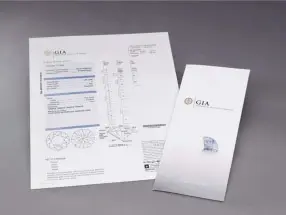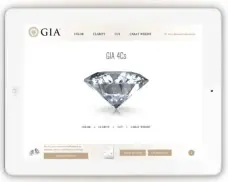
GIA (Gemological Institute of America) is considered a worldwide authority on diamonds, coloured gemstones, and pearls. As an independent organization, GIA’s mission is to protect the public trust in gemstones through education programs, laboratory services and research discoveries. Industry professionals and consumers across the globe consider GIA Grading Reports the benchmark for gemstone certification due to its impartial assessment of quality.
To begin with, each GIA Grading Report catalogues a diamond’s unique features in detail, including the 4Cs of diamond quality (colour, cut, clarity and carat weight).The report includes a unique identification number for protection in the case of theft or loss; and provides a basic description of the graded diamond for quick identification.
GIA is the 80-year old organization that created the International Diamond Grading System™ and the 4Cs of diamond quality, which grading reports are based on. A careful evaluation of the 4Cs taken together can help to determine overall value of a diamond.
Carat Weight: The carat, the standard unit of weight for diamonds and other gemstones, takes its name from the carob seed. The modern metric carat, equal to 0.2 grams, weighs exactly the same in every corner of the world.
Colour: The colour grade ranges from “D,” virtually colourless, to “Z,” representing the largest presence of colour. Keep in mind that closer the diamond is to the colourless end of the scale, the more light it will reflect. Reflected light equals more brilliance.
Clarity: Clarity is often difficult to see with the naked eye, but its characteristics can affect the overall brilliance of a diamond. Locate where your gemstone is on the clarity scale. Diamond clarity refers to the absence of internal inclusions or external blemishes. Inclusion categories range from VS (very slightly included) to SI (slightly included).
Cut: Though difficult to analyze or quantify, the cut of any diamond has three attributes: brilliance (the total light reflected from a diamond), fire (the dispersion of light into the colours of the spectrum), and scintillation (the flashes of light, or sparkle, when a diamond is moved). In 2005, GIA unveiled a diamond cut grading system for standard round brilliants in the D-to-Z color range.
While the bulk of a diamond’s value is determined by the 4Cs, the finish of a gemstone can also affect the stone’s desirability. Your grading report will reveal two key factors that impact a diamond’s finish:
Polish: The overall condition or smoothness of the diamond’s surface.
Symmetry: The exactness of the diamond’s outline and the shape, placement and alignment of its facets. The more symmetrical the stone, the more perfectly its facets will reflect light.
GIA Grading Reports include a number of reference diagrams and graphic representations to further boost consumer confidence in the gemtone they are about to buy, including:
Plot of Clarity Characteristics: Indicates the relative size and position of any clarity characteristics, whether on the surface or internal. It provides a tangible way to understand the clarity grade assigned in the report and is useful for diamond identification, as clarity characteristics are unique to each stone.
Details of Size and Cut: This scale drawing displays the exact size and cut of the diamond so a consumer is able to visualize the stone.
Security Features: All GIA Diamond Grading Reports contain a hologram, background screen, microprint lines and other security features that exceed industry guidelines, demonstrating the authenticity and integrity of every report.
Keeping with the latest technology, GIA released the 4Cs application (app) for iPad in fall 2011 to educate and engage consumers. Two versions of the app (a consumer and a retailer) feature video and interactive tools that teach how GIA grades diamonds using the 4Cs. The app explains the GIA grading scales for color, clarity, and cut, and how diamond grades can affect value. The app also explains the origins of the carat system, and provides information about fluorescence, diamond treatments and synthetics.
A special feature on the app’s consumer version, “My Diamond Wish List” enables a consumer to keep a record of the diamonds they’ve seen and considered. Consumers can enter and store a diamond’s relevant information, including its report number, 4Cs information, price, image, and the retailer’s address and contact information. If the diamond comes with a GIA report, the grading information will populate automatically from the GIA Report Check.
Today, the GIA International Diamond Grading System™ which includes the D-to-Z colour scale, Flawless to I3 clarity scale, and the Excellent to Poor cut scale, is the universal language used by virtually every knowledgeable diamond buyer in the world.
GIA is one of the few laboratories in the world with the resources to address emerging treatments head on. As one of the world’s largest grading laboratories, GIA is often the first to encounter new treatments and synthetics traveling through the pipeline. GIA invests heavily in gem research, which enables the Institute’s scientists and gemologists to conduct ongoing investigations into these materials and devise methods to identify them. These findings directly inform the testing and grading processes GIA uses in its laboratories.
The GIA laboratory in India, like all GIA laboratories worldwide, tests every diamond it grades for laser drilling, fracture filling, irradiation, high pressure/high temperature (HPHT) and chemical vapor deposition (CVD) to detect known treatments and to separate natural diamonds from synthetics. Grading reports are not issued for diamonds that have undergone unstable treatments such as coating or fracture filling. And, while grading reports may be issued for diamonds that have been laser drilled, irradiated or HPHT processed, these treatments are prominently disclosed on the report.
For further details on GIA, visit www.giaindia.in.

GIA Diamond Grading Report.

GIA 4Cs iPad Application.